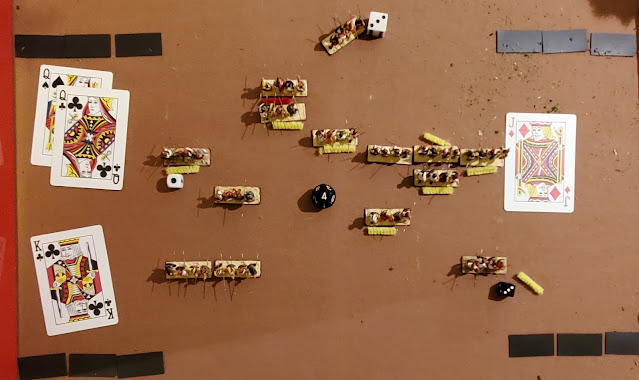One-Hour Wargames: All Needed Terrain
1. 2-Level 6x12” Hill x 2
2. 2-Level 6x12” Hill, 6’ of road
3. 2-Level 6x12” Hill, 6x6” wood, 3’ of river, 2 bridges
4. 2-Level 6x12” Hill, 6x12” wood, 3’ of road
5. 2-Level 6x12” Hill, 6x6” wood, 3’ ea. of river and road, 1 bridge
6. 2-Level 6x12” Hill, 3’ of road
7. 2-Level 6x12” Hill, 2-Level 18x12” Hill, 6x6” wood
8. 2-Level 18x12” Hill, 6x6” wood, 3’ of road
9. 2-Level 6x12” Hill, 6x6” wood, 6x6” town, 3’ ea. of river and road, 1 bridge, 1 Ford
10. 2-Level 12x12” Hill [impassible”], 12x12” wood, 6x6” town, 3’ of road
11. 12x12” wood, 6x6” Swamp,6’ of road
12. 2-Level 6x12” Hill, 6x6” town, 3’ ea. of river and road, 1 bridge, 1 Ford
13. 2-Level 6x12” Hill, 12x12” wood, 3’ of road
14. 2-Level 6x12” Hill, 12x12” wood, 6x6” town, 3’ of road
15. 12x12” wood, 6x6” town [“fortification”] x2
16. 2-Level 6x12” Hill, 6x12” wood, 6x6” town, 3’ of road
17. 2-Level 6x12” Hill
18. 6x6” town, 3’ ea. of river and road, 1 bridge, 2 Fords
19. 6x12” wood, 3’ ea. of river and road, 1 bridge, 1 Ford
20. 2-Level 6x12” Hill, 6x6” wood x2, 3’ of river, 2 Fords
21. 2-Level 12x12” Hill, 1.5’ of road, 1.5’ of swamp [3” wide], 6x6” town
22. 2-Level 6x12” Hill, 36x12” wood, 6x6” town [“fortification”]
23. 2-Level 6x12” Hill, 6x6” wood x3, 8x8” town, 3’ ea. of river and road, 1 bridge, 2 Fords
24. 12x12” wood, 12x12” Swamp, 3’ of road
25. 2-Level 6x12” Hill, 12x12” wood, 3’ of road
26. 2-Level 6x12” Hill, 6x6” wood, 6x12” wood x2, 3’ ea. of river and road, 1 bridge
27. 6’ of road
28. 2-Level 18x12” Hill, 6x6” town, 3’ of road
29. 2-Level 18x12” Hill
30. 2-Level 18x12” Hill, 6x12” wood, 8x8” town, 3’ ea. of river and road, 1 bridge, 1 Ford
Roads & Rivers: 3” width – could model narrower with cleared berms and banks
· 4 HILLS: 2-Level 6x12” Hill x 2, 2-Level 18x12” Hill, 2-Level 12x12” Hill [“rough”],
· 6 WOODS: 6x6” wood x3, 6x12” woodx2, 12x12” wood,
· 2 x 6x6” towns, 8x8´town, 6’ of road, 2x Bridges, 2xFords
· 3’ of river, 6x6” Swamp, 6x12” Swamp, 12x12” Swamp
Obviously, some terrain pieces could be built up from two-three others, like making a 12x12” wood from 2 6x6” woods and one 12x6” wood, for example. There are a couple of scenarios with a 24”x 6” Hill but the 18” long one will do just as well, or you can put together the two 6x12” Hills, you’ll just have a saddle in the center. There’s also a giant woods in one scenario, 1’x3’, but probably best done by marking the line of the table with string/yarn, and distributing the 4 Woods into the space.

























































